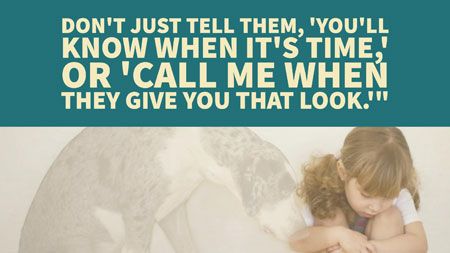Euthanasia: Too soon? Not soon enough?
Hospice and euthanasia are all about timing. Dr. Mary Gardner offers to guide clients through the process of their final gift to their petsaying goodbye.

You've seen the seemingly happy hospice dog bound into your clinic, and you're surprised when the client says, "We're ready to say goodbye." The part you missed: the pooch's frantic pacing and whining at 2 a.m. You've seen the obviously painful pet that needs to be let go-but the pet parents have their denial goggles firmly in place. How do you answer these tough situations when the pet and the pet parent are both feeling pain?
First, offer education. The veterinary team is in a perfect position to help families whose pets have entered hospice, says CVC educator Mary Gardner, DVM. You have to make sure you educate the owner about the disease the pet is facing and the progress that the disease is going to present to the family and to the pet. And you must make sure that they have all of their questions answered," she says.
Next, offer nonjudgmental support. What does that look and sound like? Dr. Gardner explains here:
"Once a pet is in hospice let the family know that at any time during this phase when they're ready to say goodbye you support that decision," Dr. Gardner says. "Because when their Lab was up at 2 o'clock in the morning pacing and panting and they call you at 8 a.m., they don't really want to be judged that they had a really bad night and tonight's the night [to euthanize the pet]. That Lab may come in to your clinic looking kind of good, but you weren't there all day. So make sure you understand what the family is going through, because the family may be suffering even if the pet is not."
Remember clients are experiencing an emotional, stressful decision. Answer their questions and give them the tools they need to make the best decisions. Then support them through the whole process.
Finally, advocate the pet's perspective with quality-of-life exercises.
"I've often helped families where I look at the pet and I think, 'Oh my goodness, this pet is suffering, and we need to intervene.' But I'll have one or more family members who aren't ready and they may not be seeing what I'm seeing. And I call that denial goggles," Dr. Gardner says. "I think we can all appreciate as pet parents, you don't ever want to say goodbye. And I understand when pet owners put those goggles on."
So when you see a pet not doing well and you need to help the family, Dr. Gardner suggests doing quality-of-life scales with the owner. "Don't just tell them, 'You'll know when it's time,' or 'Call me when they give you that look,'" she says. "And don't say, 'Call me when he stops eating.' Because we all know that 70-pound Lab that has arthritis is still going to eat till the very end and still wag his tail."
She says the goal is to give pet owners many different tools they can use, and there are many quality-of-life scales available. (For example, Dr. Alice Villalobos' Quality of Life Scale, this client handout from the Argus Institute or the coin jar exercise.) The critical point: Do them with the owner. Because sometimes pet owners may cheat a little bit and give their pets a better score than reality.
And if the pet parents still aren't ready, Dr. Gardner suggests talking about euthanasia. Many pet owners don't even know the process, and they may think it's painful. Or maybe they had a bad experience before and they're nervous about this time.
"So if you explain up front about when to say goodbye and how they can make that appointment-so it doesn't need to be scary, then maybe they'll be a little bit more comfortable when that decision needs to be made," she says.
Veterinary Heroes: Patricia Kennedy Arrington, DVM, CVFP
December 1st 2024As a leader in 24-hour veterinary care and a champion for women in the field, Patricia Kennedy Arrington, DVM, CVFP, has dedicated her 50-year career to transforming veterinary medicine and inspiring future practitioners.
Read More